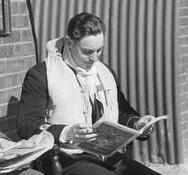Arthur Blake (Royal Navy officer) facts for kids
Quick facts for kids
Arthur Blake
|
|
|---|---|
 |
|
| Nickname(s) | 'Admiral' 'Sailor' |
| Born | 16 September 1917 Gateshead, England |
| Died | 29 October 1940 (aged 23) Chelmsford, England |
| Allegiance | United Kingdom |
| Service/ |
Royal Navy |
| Rank | Sub-lieutenant |
| Unit | No. 19 Squadron |
| Battles/wars | Second World War |
Arthur Giles Blake (born 12 September 1917 – died 29 October 1940) was a brave British pilot during the Second World War. He was part of the Royal Navy and became known as a flying ace. This means he shot down five enemy aircraft in air battles.
Arthur Blake was born in Gateshead, England. In 1939, he joined the Royal Navy and trained to become a pilot. He flew with the Fleet Air Arm, which is the Navy's air force. During the Battle of Britain, he joined the Royal Air Force (RAF) to help defend the country. He was a pilot in No. 19 Squadron and fought many air battles. Sadly, he died in action just before the Battle of Britain ended.
Contents
Arthur Blake: Early Life and Training
Arthur Giles Blake was born in Gateshead, England, on 12 September 1917. He was one of eight children. His family later moved to Slough, where he went to school. After finishing school, Arthur worked as a clerk.
In 1938, he decided to join the Royal Navy. He wanted to become a pilot in the Fleet Air Arm. He was accepted and started his training in early 1939. Arthur first went to the Royal Naval College in Greenwich.
In August, he began learning to fly at Gravesend. He flew de Havilland Tiger Moth planes, which are used for training. The next month, he was promoted to acting sub-lieutenant.
Flying in the Second World War
By November 1939, the Second World War was already happening. Arthur Blake continued his pilot training. He went to No. 1 Flying Training School. There, he flew more advanced planes like the North American Harvard and the Fairey Battle.
In March 1940, he earned his pilot's "wings." This meant he was a fully qualified pilot. He was also confirmed as a sub-lieutenant. He then trained on the Blackburn Skua. This plane was a fighter and dive bomber designed to fly from aircraft carriers.
The Battle of Britain Begins
After the Battle of France, the RAF's Fighter Command needed many new pilots. They had lost a lot of pilots in the fighting. To help, the Admiralty sent over 50 Navy pilots, including Arthur Blake, to the RAF.
Before joining a fighter squadron, Blake learned to fly the Supermarine Spitfire. This was a very famous British fighter plane. In July, he joined No. 19 Squadron. His fellow pilots gave him the nicknames 'Admiral' and 'Sailor'. He stood out because he wore his dark blue Navy uniform.
His squadron flew Spitfires from Duxford. They were part of No. 12 Group. Their job was to patrol over the North Sea and protect ships.
Blake's First Fights
Arthur Blake's first few weeks with the squadron were quiet. His first battle with the German air force, the Luftwaffe, was on 25 August. His squadron and two others fought many German planes over the Thames estuary.
As the Battle of Britain became more intense, No. 19 Squadron fought over London. At first, their planes had problems with their cannons. So, in September, they switched back to Spitfires with machine guns. On 3 September, Blake damaged a German Messerschmitt Bf 110 fighter plane. Six days later, he shot down a Heinkel He 111 bomber over London.
Battle of Britain Day
15 September was a very important day, later called Battle of Britain Day. The Luftwaffe launched two huge bombing attacks on London. No. 19 Squadron was part of a large group of fighters called the Duxford Wing. This was one of the first times so many fighters flew together.
The Duxford Wing flew again in the afternoon. They were still climbing when German Messerschmitt Bf 109 fighters attacked them. These fighters were protecting the bombers. Squadron Leader Douglas Bader, who led the wing, told No. 19 Squadron to go after the bombers. He led the other squadrons to fight the Bf 109s.
On this day, Blake damaged a Dornier Do 17 bomber. He also destroyed a Bf 109. With three other pilots, he helped destroy a Heinkel He 111 bomber. All these battles happened over London. His Spitfire was damaged, and he had to crash-land, but he was not hurt.
Final Flight and Legacy
On 17 September, Arthur Blake destroyed two more Bf 109s while flying over Canterbury. On 29 October, just two days before the Battle of Britain officially ended, Blake was flying at the back of his squadron. He was attacked by Bf 109s.
The rest of his squadron did not see what happened. His Spitfire crashed near Chelmsford in Essex, and he was killed. Arthur Blake was one of seven Navy pilots who died during the Battle of Britain.
Arthur Blake is remembered for shooting down five German aircraft. He also damaged two others. He is buried at Langley, near Slough, in the churchyard of St Mary's Church.


